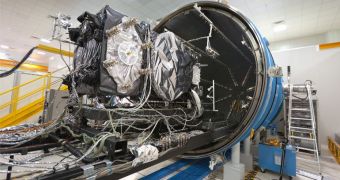The next two Galileo satellites to launch in orbit have just completed their vacuum and temperature assessments successfully, at the test facility that main contractor Thales Alenia Space operates in Rome, Italy. Each of the vehicles spent 20 days in the test chamber.
TAS builds Galileo satellites for the European Space Agency (ESA), which is in turn responsible to the European Commission for the deployment and operations of the old continent's own satellite navigation and positioning system.
All major powers, including China and the Russian Federation, are currently assembling similar systems, since they do not want to remain dependent on the United States and its Global Positioning System (GPS).
ESA launched the first two spacecraft of its constellation on October 21, 2011, aboard a Soyuz-FG delivery system provided by the Russian Federal Space Agency (RosCosmos). For Galileo, the Europeans built a dedicated Soyuz launch pad at their spaceport at Kourou, in French Guiana.
The Galileo In-Orbit Validation (IOV) satellites are already in orbit, and are performing according to specifications. The new pair of vehicles will join them in space after launch. September 28 has been scheduled as a tentative launch date.
The new spacecraft will take off from the same Kourou Spaceport launch pad as their predecessors, also aboard a Soyuz-FG rocket. Both have now been cleared for flight, with TAS engineers saying that they passed the cryogenics tests with flying colors.
“These two satellites are almost identical to the first two Galileo satellites that were launched last 21 October. So we don’t need to carry out full-scale qualification tests because we already know from our in-orbit test campaign that the design performs to our expectations,” ESA expert Nigel Watts says.
“Instead, what we are carrying out is acceptance testing: checking the workmanship, performance and readiness to launch of these new satellites,” he adds.
When completed, ESA's satellite navigation network will be the most precise in the world, thanks to the extreme accuracy of the atomic clocks aboard its spacecraft.

 14 DAY TRIAL //
14 DAY TRIAL //